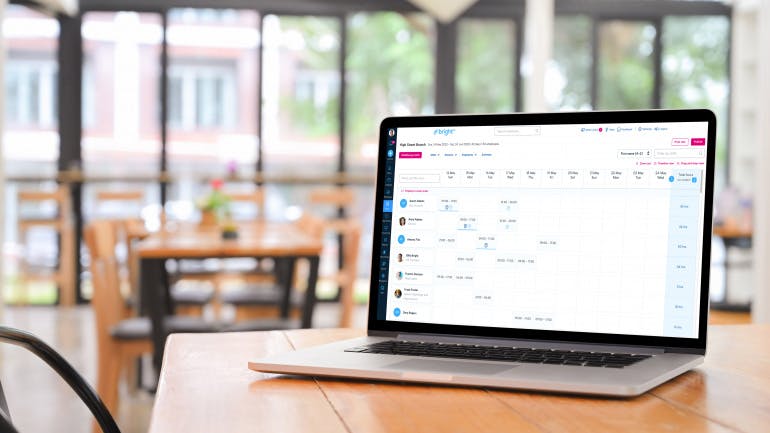First published on Wednesday, July 10, 2024
Last updated on Wednesday, July 10, 2024
Employee clocking systems are not a new concept in the world of work. From punch cards to more advanced systems like clocking in software. Yet as a small business owner, did you know that both you and your workforce will benefit from rolling out a clocking in and out policy?
Your business will become more efficient, yes. And you could save on payroll and be less likely to lay off staff, make redundancies or face other business challenges.
This creates a happier, more secure working environment as we’ll see in this article. Be prepared (ahead of time) by exploring how clocking in software can improve your business operations.
One part of a wider employee monitoring programme
You want your employees to be punctual and work the hours they have been assigned. After all, it’s you who has to foot the bill if they don’t turn up to work.
But you don’t need to be there in person to monitor their working hours with employee clocking systems. Freeing you to network or visit clients on the road, clocking in software gives you back precious time.
This means you can work smarter, focusing on where you need to be. Employee concerns about clocking in can be relaxed by explaining that this system only monitors and records hours worked. Namely the hours they should be working for you. This goes a long way to reassure employee concerns about privacy.
Other aspects of employee monitoring programmes can be less popular. For example, monitoring their computer use. While it may give you peace of mind that you can make sure no one is working on a non-work-related project or a ‘side hustle’, your staff may not feel the same way.
However, as clocking systems are only one part of employee monitoring programmes, your employees will understand its introduction when you explain the benefits. In fact, according to a survey by Axios, 80% of employees trust that their employer will monitor them appropriately at work. So, it really does come down to how you communicate and build trust with your team.
Make colleagues accountable
Office-based employees
Employee clocking systems, like Blip, let you see who’s attending work on time. This type of clocking in software also makes employees accountable for their work, attendance, and any frequent lateness. Transferring the responsibility to employees means you will no longer have to chase them for their hours worked.
Employees not clocking in and out is unfair to decision-makers and business owners. It also takes advantage of their colleagues who arrive on time and work hard.
Time-tracking software creates a fairer, more productive environment for all. Everyone will be more conscientious knowing their workday or shifts will be monitored.
Remote and hybrid employees
Digital time-tracking software also ensures that remote-based employees are working when they should be. A survey by the Office for National Statistics found that 44% of UK employees work from home.
So, whether you have remote or hybrid workers, clocking in software will help you keep track of your entire team’s attendance and working hours.
Systems like Blip allow you to easily discover who’s logged on, absent or on a break with real-time updates you can access on an app or desktop. Blip’s secure geolocation tracking allows successful remote working and reassures employers’ concerns.
Overall, employee clocking systems encourage increased productivity. Reduced leads, sales and output can be queried with real-time data to support your claim. This can improve the quantity and quality of their work. It also benefits your employees as high performance can be fairly rewarded.
Increased employee satisfaction
One way of rewarding hardworking employees is a company rewards system. By rewarding productivity as a company, you will set an example of what is expected. This motivates your employees who want to do their very best. It also encourages a fairer, more productive team ethos where everyone contributes.
Improved employee satisfaction is shown to reduce stress. This is important as a stressful work setting makes individuals almost three times more likely to resign, according to a study by Gallup. This applies to all levels throughout your business.
By using an employee clocking system, your staff will gain peace of mind that their working hours are recorded correctly with full transparency. That way everyone is paid fairly for their effort. Plus, if you use a system like Blip your forgetful staff are also reminded to log their hours thanks to auto-alerts.
A happier workplace is a more productive workplace. This means you’ll reduce high staff turnover due to employee dissatisfaction. Therefore, your business will require less in-house or outsourced recruitment, saving costs and time.
This also avoids your existing employees having to cover the work of those who have left. More established teams build stronger long-term working relationships which also boosts productivity through collaboration.
Enhanced onsite security
A clocking-in and out policy makes for a more secure workplace. By knowing who has been present, workplace incidents can be investigated more quickly. This helps you plan and even prevent similar events from happening in the future. Clocking in software acts as your friendly deterrent because it reports who was on the premises at any specific moment.
Stock loss, theft or negligence can lead to stress, lost work, and increased costs. Between 2019 and 2022, 18,784 employee thefts were reported to the police in England, Northern Ireland and Wales.
A clock-in system can help investigate incidents with an accurate record of who is in and out of your workplace at any time. This saves business owners and HR professionals valuable time that can be focused elsewhere on boosting productivity.
Prevents overworking employees
Employee clocking systems ensure your employees’ welfare by preventing them from working too many hours. Not only are you legally required to log employees’ hours, but this avoids worker resentment. It further helps reduce employee churn among overworked staff members.
As a business leader, you will benefit from monitoring staff working hours. Logging how many hours each member of staff has worked, helps you stay on the right side of the law.
Normally, an employee cannot work more than 48 hours when averaged over 17 weeks. This is due to the working time directive, also known as working time regulations. The rule does vary by sector, however, with exceptions including security and care industries. Here, staff must be present 24 hours a day.
Should workers agree to ‘opting out’ of the 48-hour limit, clocking in software plays a vital role in your business. It helps you or your finance team to accurately calculate payroll—reducing back-and-forth communications.
Start improving your business operations with Blip
All of the benefits seen above contribute to your business’s overall productivity. That’s efficiency which means a healthier, more sustainable business that can continue to grow, reward employees, and provide stability for your workforce.
That’s why you need a clocking system, and BrightHR can help with that, with our clock-in and out system Blip. Everything is visible on Blip, with no time needed to interpret handwriting or manually enter hours. This includes breaks and overtime.
Make gathering missing or inaccurate paperwork a thing of the past. It’s time to forget the frustration of chasing timesheets!
Discover how your business can boost productivity by booking a demo today.










